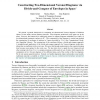Free Online Productivity Tools
i2Speak
i2Symbol
i2OCR
iTex2Img
iWeb2Print
iWeb2Shot
i2Type
iPdf2Split
iPdf2Merge
i2Bopomofo
i2Arabic
i2Style
i2Image
i2PDF
iLatex2Rtf
Sci2ools
139
click to vote
TCOS
2010
2010
Constructing Two-Dimensional Voronoi Diagrams via Divide-and-Conquer of Envelopes in Space
We present a general framework for computing two-dimensional Voronoi diagrams of different classes of sites under various distance functions. Most diagrams mentioned in the paper are in the plane. However, the framework is sufficiently general to support diagrams embedded on a family of two-dimensional parametric surfaces in R3. The computation of the diagrams is carried out through the construction of envelopes of surfaces in 3-space provided by CGAL (the Computational Geometry Algorithm Library). The construction of the envelopes follows a divide-and-conquer approach. A straightforward application of the divide-and-conquer approach for Voronoi diagrams yields algorithms that are inefficient in the worst case. We prove that through randomization, the expected running time becomes near-optimal in the worst case. We also show how to apply the new framework and other existing tools from CGAL to compute minimum-width annuli of sets of disks, which requires the computation of two Vorono...
| Added | 30 Jan 2011 |
| Updated | 30 Jan 2011 |
| Type | Journal |
| Year | 2010 |
| Where | TCOS |
| Authors | Ophir Setter, Micha Sharir, Dan Halperin |
Comments (0)

